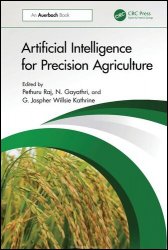Artificial Intelligence for Precision Agriculture
- Добавил: literator
- Дата: 18-11-2024, 21:31
- Комментариев: 0
 Название: Artificial Intelligence for Precision Agriculture
Название: Artificial Intelligence for Precision AgricultureАвтор: Pethuru Raj, N. Gayathri, G. Jaspher Willsie Kathrine
Издательство: CRC Press
Год: 2025
Страниц: 322
Язык: английский
Формат: pdf (true), epub
Размер: 25.5 MB
Precision agriculture is a next-generation farming management concept that optimizes resource use, productivity, quality, profitability, and sustainability by observing and responding to crop variability. Precision agriculture employs digital technologies such as the Internet of Things (IoT), Artificial Intelligence (AI), 5G communication, cybersecurity, edge computing, cloud-native principles, and blockchain to ensure crops and soil receive exactly what they need for optimal health and productivity.
Artificial Intelligence for Precision Agriculture explores the latest developments in precision agriculture, detailing how AI contributes to its goals. The book discusses how precision agriculture solutions use IoT devices, data storage, AI analytics, connectivity, and cloud infrastructures to analyze factors such as soil type, terrain, weather, plant growth, and yield data. It also examines edge technologies—sensors, microchips, beacons, RFID tags, robots, drones, and actuators—that collect field data and transmit it to cloud-based AI platforms for analysis. The book shows how AI-driven insights guide actions in the field, such as crop rotation, optimal planting and harvesting times, and soil management, and help farmers apply the right amounts of water, fertilizers, and pesticides, reducing waste and environmental impact.
Machine Learning is a technique that uses mathematics and statistical learning to create a model that helps in predicting the values which are not known prior. In Machine Learning, we try to solve problems with computers without explicitly programming them for a specific task. It means learning from past data. It makes use of historical information/data for making predictions. In Traditional Programming, we give data and program to the computer to give output, but in Machine learning, we give data and output to the computer to get the program as output. In simple language, whenever a machine tends to learn from its experience, we say that Machine Learning is playing its role. Based on the experience, it improves its performance on every iteration.
The process of Deep Learning, also referred to as “deeper learning,” is a subfield of Machine Learning that focuses on creating and using neural network simulations inspired by the structure and operation of the human cerebral cortex. It is a subset of Artificial Intelligence (AI) that has historically flourished due to its amazing capacity for learning and making predictions based on the large quantities of data that is currently available.
Learning techniques are designed to eventually differentiate between supervisors and lower-level attributes, enabling them to effortlessly pick up on data with hierarchical representations. These methods’ fundamental components are artificially generated neural networks, sometimes known as deep cognitive networks. They are created by making up different hyperlinking layers of synthetic nerve cells. A neuron gets input from the surrounding environment and interprets it using mathematical information, followed by passing its findings to the layer of axons beneath it. The network develops the ability to spot patterns and make predictions as a result of the aforementioned procedure.
Among its primary benefits is that it reduces the need for tedious feature engineering by proactively acquiring how to represent features from raw data. It is used in tasks like speech detection, natural language processing, and image recognition. Deep Learning involves training neural networks with labeled datasets to modify internal parameters through optimization algorithms like stochastic gradient descent (SGD), achieving groundbreaking results in various domains but facing challenges such as the need for large labeled datasets and computational resources, as well as overfitting issues. Ongoing research aims to address these challenges and advance the field.
Applications covered in the book include:
Drone-based high-resolution field mapping
Tracking crops
Crop yield assessments
Data collection for irrigation, fertilization, and crop management
Advanced weather monitoring
Equipment management
With chapters on AI model development, plant disease detection and remediation, sustainable farming techniques, data integration, AI-enabled data analytics, and knowledge visualization, this book is a comprehensive guide to technologies and applications in precision agriculture.
Contents:
Скачать Artificial Intelligence for Precision Agriculture
Внимание
Уважаемый посетитель, Вы зашли на сайт как незарегистрированный пользователь.
Мы рекомендуем Вам зарегистрироваться либо войти на сайт под своим именем.
Уважаемый посетитель, Вы зашли на сайт как незарегистрированный пользователь.
Мы рекомендуем Вам зарегистрироваться либо войти на сайт под своим именем.
Информация
Посетители, находящиеся в группе Гости, не могут оставлять комментарии к данной публикации.
Посетители, находящиеся в группе Гости, не могут оставлять комментарии к данной публикации.

